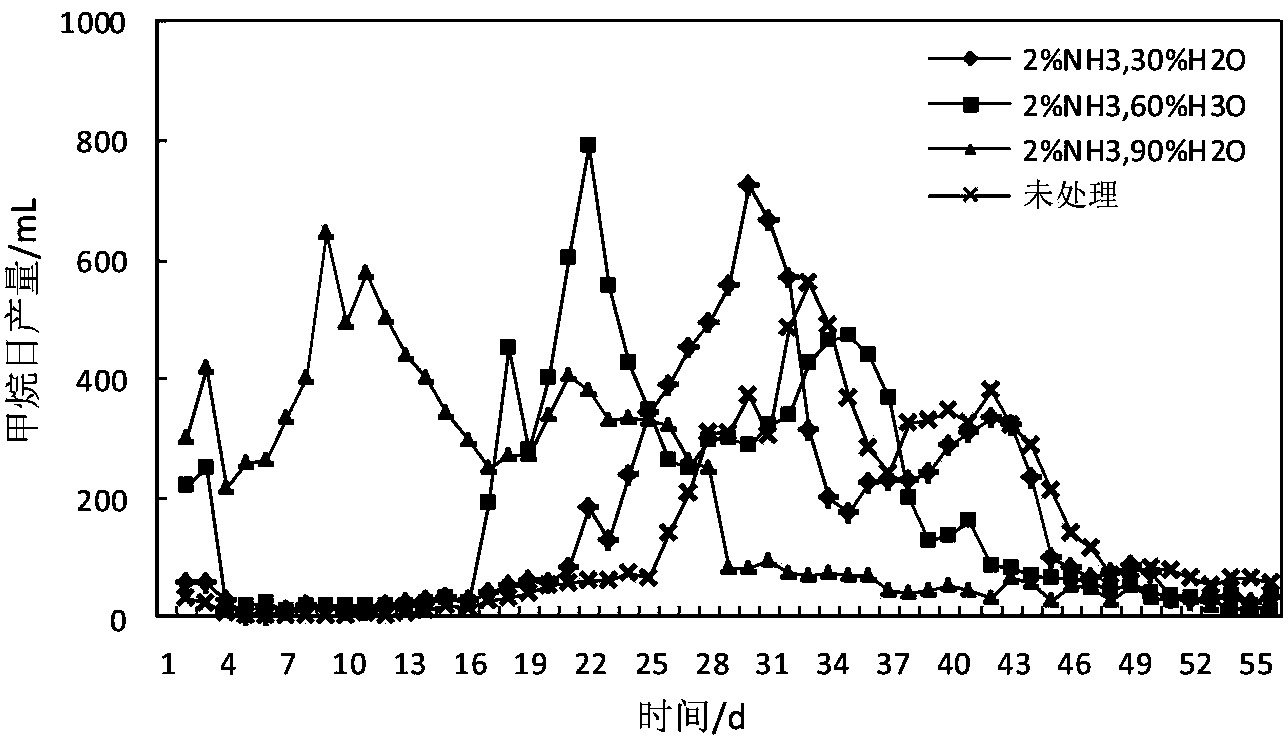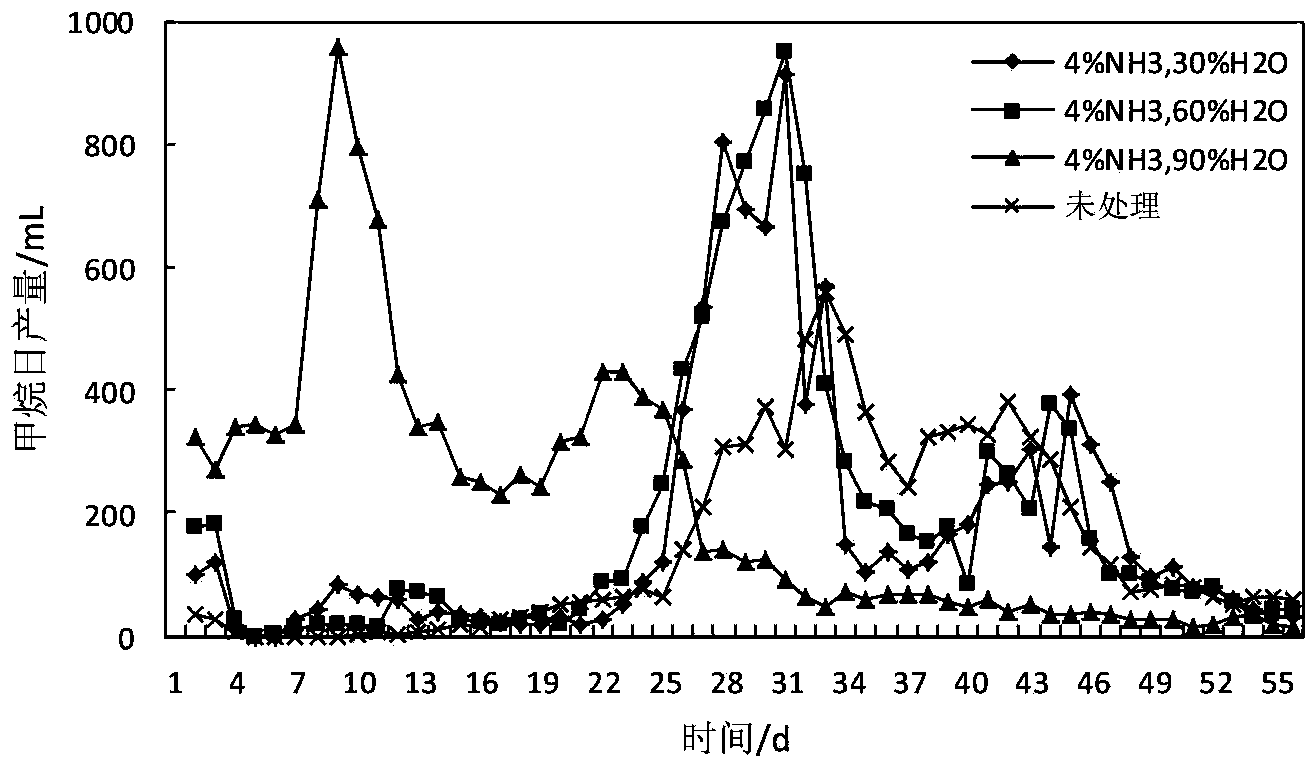Method for improving straw methane yield through pure ammonia wet process soaking normal temperature pretreatment
A pretreatment and straw technology, applied in fermentation, waste fuel, etc., can solve the problems of long ammoniation pretreatment time, achieve the effects of shortening the anaerobic fermentation cycle, enriching the output N source, and improving the gas production performance
- Summary
- Abstract
- Description
- Claims
- Application Information
AI Technical Summary
Problems solved by technology
Method used
Image
Examples
Embodiment 1
[0022] Weigh three parts of straw, the amount of each part is 52g (calculated in TS), and evenly mix 2% of the dry weight of the straw with a certain amount of water and spray it on the crushed straw, add a certain amount of water to the straw Water and 25%NH in 3 ·H 2 The water in O is 30%, 60%, 75% and 90% of the dry weight of straw, and 2% of pure ammonia is converted to 25% NH 3 ·H 2 The amount of O was 4.16mL, and the amount of additional water was 17mL, 74mL, 206.40mL and 472mL. The pretreated straw was sealed and sealed in a ziplock bag, and pretreated at 30°C for 96 hours. The control group was rice straw pretreated with 30% moisture content and non-pretreated rice straw.
[0023] The pretreated straw was mixed with 12g of anaerobic sludge, added to the anaerobic digestion reactor, and tap water was added to 80% of the reactor volume. Put the reactor filled with nitrogen gas and sealed after adding the materials into a shaker at 32°C, and shake it. Record the dai...
Embodiment 2
[0032]Weigh three portions of straw, each portion of straw is 52g (calculated in TS), mix evenly 4% of the dry weight of the straw with a certain amount of water and spray it on the crushed straw, add a certain amount of water to the straw Water and 25%NH in 3 ·H 2 The water in O is 30%, 60%, 75% and 90% of the dry weight of straw, and 4% of pure ammonia is converted to 25% NH 3 ·H 2 The volume of O was 8.32mL, and the additional water volumes were 14mL, 72mL, 207.45mL and 478mL. The pretreated straw was sealed in a ziplock bag, and pretreated at 30°C for 96 hours. The control group was rice straw pretreated with 30% moisture content and non-pretreated rice straw.
[0033] The pretreated straw was mixed with 12g of anaerobic sludge, added to the anaerobic digestion reactor, and tap water was added to 90% of the volume of the reactor. Put the reactor filled with nitrogen gas and sealed after adding the materials into a shaker at 37°C and shake it. The daily gas production...
Embodiment 3
[0042] Weigh three parts of straw, the amount of each part is 52g (calculated in TS), and evenly mix 6% of the dry weight of the straw with a certain amount of water and spray it on the crushed straw, add a certain amount of water to the straw Water and 25%NH in 3 ·H 2 The water in O is 30%, 60%, 75% and 90% of the dry weight of straw, and 6% of pure ammonia is converted to 25% NH 3 ·H 2 The amount of O was 12.48mL, and the additional water was 12mL, 71mL, 208.49mL and 484mL. The pretreated straw was sealed in a ziplock bag, and pretreated at 30°C for 96 hours. The control group was rice straw pretreated with 30% moisture content and non-pretreated rice straw.
[0043] The pretreated straw was mixed with 12g of anaerobic sludge, added to the anaerobic digestion reactor, and tap water was added to 80% of the reactor volume. Put the reactor filled with nitrogen gas and sealed after adding the materials into a shaker at 37°C and shake it. The daily gas production is recorde...
PUM
 Login to View More
Login to View More Abstract
Description
Claims
Application Information
 Login to View More
Login to View More - R&D
- Intellectual Property
- Life Sciences
- Materials
- Tech Scout
- Unparalleled Data Quality
- Higher Quality Content
- 60% Fewer Hallucinations
Browse by: Latest US Patents, China's latest patents, Technical Efficacy Thesaurus, Application Domain, Technology Topic, Popular Technical Reports.
© 2025 PatSnap. All rights reserved.Legal|Privacy policy|Modern Slavery Act Transparency Statement|Sitemap|About US| Contact US: help@patsnap.com



